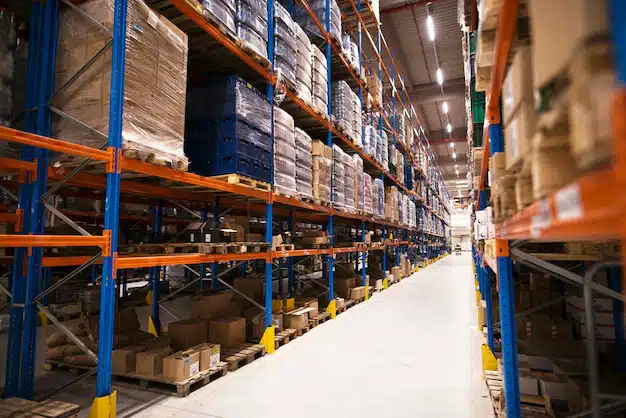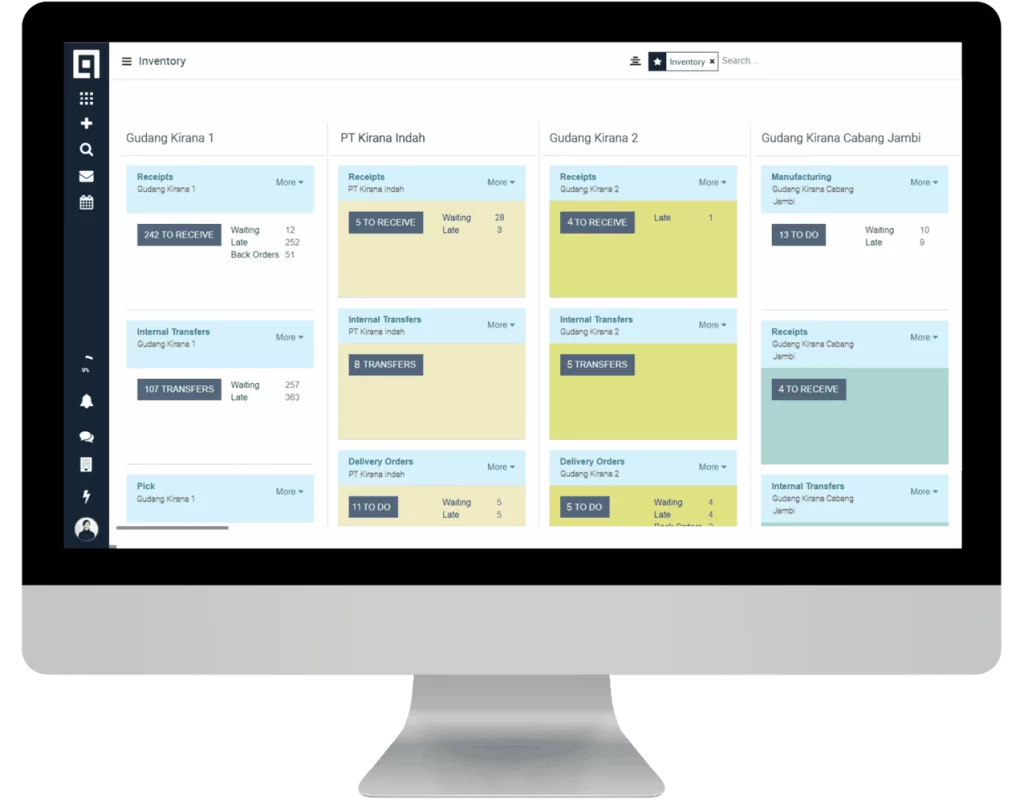A warehouse is a critical component in the supply chain, responsible for storing products or goods and providing status and condition information. Warehousing ensures that goods are distributed to designated destinations efficiently and on demand, playing a key role in business operations.
Without modern warehouse management systems, businesses often face challenges such as inventory inaccuracies, delayed shipments, and inefficient use of space. These issues can lead to increased operational costs, customer dissatisfaction, and ultimately, lost revenue.
For an optimized solution, consider Warehouse Management System, which offers real-time inventory tracking and automated reporting. These features enhance operational efficiency, reduce errors, and improve decision-making, ensuring seamless warehouse operations.
Table of Content:
Table of Content

What is Warehouse?
A warehouse is a building for storing products, packing, and preparing before distribution which is usually used by manufacturers, wholesalers, customs, etc. The difference with an ordinary warehouse is that it is a system that provides information about the availability of stock of goods, the condition of goods, and the status of delivery of goods.
This system has an important role in supply chain management; in other words, it is a supply chain system that will always be up to date and only certain employees have access, according to regulations.
In addition, it is an integral part of the modern supply chain which involves the process of sourcing, producing, and distributing goods or products. Starting from raw materials, and processing semi-finished products to finished products.
Not only that, but a warehouse will be very important to coordinate the distribution of goods resulting from the imbalance between supply and demand. The process is often referred to as warehouse distribution, in which goods are stored and then moved accordingly. Inventories of these goods require space such as temporary storage facilities called warehouses.
In warehouse management, there are several principles, namely the speed of market delivery and meeting demand, accuracy in running the supply chain continuously, customers can get products easily and quickly, and information related to inventory in the warehouse is easier.
Also read: Warehouse Staff: Understanding, Tasks, and Criteria that the Company Wants
Purpose of a Warehouse

To support the mobility of logistics businesses or the like, warehouses need to be built in buildings that meet specific criteria so that logistics activities run smoothly.
- Serves as transportation (reduction of production costs), which plays a role in controlling and efficiency of transportation and production costs. Even though an item has a large amount of production but the demand is small, the company can store the item in a warehouse.
- Functions as coordination of supply and demand, meaning that the warehouses are a safe place to store goods when demand in the market fluctuates.
- Functioning as a production requirement, not only storing goods but also playing a role in the final production process. For example, wine and cheese require a longer shelf life, so the product quality is good.
- Functioning as a marketing consideration, it means the warehouse as a solution in product distribution to simplify and speed up the delivery of goods.
Also read: 5 Benefits of Warehouse App
The Benefits of the Warehouse
The warehouse itself has various advantages and important benefits that can support the company’s operational activities. The following is an explanation of what are the benefits of having a warehouse:
1. Increasing effectiveness
Effectiveness that allows customers or users to access or obtain company-owned products easily.
2. Reduce expenses
All equipment that the company uses manually does not really need them so they can reduce business operational costs. Because the warehouse they have created is structured.
3. Faster business processes
One of the company’s competitive strategies is to supply products as close to the market as possible so that the marketing or delivery process can be faster.
4. Satisfaction
Next, Increase customer satisfaction because the preparation of goods does not require a long time.
Also read: 7 Warehouse Management Practices to Improve Inventory Control
Functions Warehouse
Warehouses have a function other than a place to store goods and several other functions. There are four functions of the warehouses, namely:
1. Storage of Goods
The main function of the warehouse is as a place to store goods. In storing goods, it must be neat and according to the plan so that in the retrieval process there is no confusion, especially in bonded warehouses that accommodate a lot of goods.
2. As Product Security
Furthermore, they can be reused as security for inventory or goods sent, and orders to keep them intact. The function of the warehouse is not only in terms of theft prevention but also disaster mitigation.
3. As a Packaging Maker
The third function is as a packing builder, the company will use the warehouse as an assembly facility or a place for packing and bundling. Semi-finished goods or products can be perfected in the warehouse and sent to customers.
4. To Increase Inventory and Re-Order
One of the difficulties in managing the warehouses is determining the time to reorder goods because the available stock is in various warehouse locations.
Types of Warehouse
The warehouses are classified into 3 types, each of which has its characteristics. The following is an explanation of each type of warehouse:
1. Raw material (Inventory Room)
This type of warehousing stores every material needed by the production process. This type of warehouse is divided into two types of rooms: in the factory building or production room (indoor) and some materials stored outside the building (outdoor).
2. Working process storage
Goods stored in this type of warehouse are goods or materials that are in the process of being worked on or in production. So, you can find types of warehouses’ work process storage in the manufacturing industry.
The reason is, that in the industry the materials needed must pass the operation selection and production work first.
3. Finished goods storage
As the name implies, a finished goods storage warehouse stores products that have been completed and are ready for distribution. To ensure efficient tracking and minimize errors, businesses often integrate barcode tracking software, which helps monitor inventory levels and streamline warehouse operations.
Also read: Benefits of Safety Stock in the Company’s Supply Chain
Responsibilities
In addition to their various functions and types, warehouses also have several responsibilities that they must fulfill. The following is an explanation:
- Controlling and being responsible for the storage of goods, damage, theft, fire, and damage to the condition of goods.
- Responsible for loading and unloading goods and co-signing receipts and travel documents.
- Responsible for cleanliness in the area.
- Have responsibility for the accuracy of reports.
- Signing travel documents or other legal documents from suppliers.
- Refuse to remove goods if they do not conform to established procedures.
- Prevent unauthorized persons from entering the area.
- Organizing Requirements related to facilities.
- Set the position and location of products.
- Offer promotions, demotion, and mutations to subordinates.

Methods of Storage of Goods
You can do five ways of storing goods in a warehouse, as follows:
1. Dedicated storage
The dedicated storage method, also known as a fixed location, is the first way to store goods in a warehouse. This method of storing goods in the warehouse means that each product has a fixed place or storage location. Also, the location cannot be changed or used by other types of products even if there is a space.
2. Randomized Storage
Second, there is a method of randomized storage or floating lot storage, which is a way of storing goods that is the opposite of the dedicated storage method. The randomized storage method means that storage in the warehouse can be done randomly. Goods or products may change storage location. And then, storage can also be done in any place possible.
3. Class-based storage
Third, the method for storing goods in the next warehouses is the class-based storage method. This method is a combined method of dedicated storage and randomized storage. The class-based storage method is to arrange the location for storing goods in the warehouses more flexibly but still neatly.
4. Shared storage
Fourth, is the use of the shared storage method, which is a method of storing goods in warehouses that aims to reduce the need for storage space for goods. The shared storage method prioritizes the advantage of differences in the storage time of goods in the warehouse. In addition, it is important to determine the items carefully based on the storage space used.
5. Cube per order index policy
Finally, there is a method of storing goods in the last warehouses, which is the cube-per-order index policy. The cube-per-order index policy method stores goods in the warehouse by paying attention to the storage space requirements for goods in the warehouse with the number of product transactions. In addition, the cube-per-order index policy method means setting product locations based on product categories and product movement distances.
How to Simplify Warehouse Management?
Managing a warehouse efficiently can be challenging, especially as businesses grow and inventory levels increase. Keeping track of stock, ensuring timely order fulfillment, and maintaining optimal warehouse organization require a systematic approach. Without the right tools, manual processes can lead to errors, inefficiencies, and delays. This is where a Warehouse Management System (WMS) plays a crucial role in simplifying and streamlining warehouse operations.
A Warehouse Management System is a software solution designed to automate and optimize warehouse processes, from inventory tracking to order processing. By leveraging real-time data, businesses can monitor stock levels, reduce errors, and improve overall warehouse efficiency. A WMS also enhances accuracy in order fulfillment by guiding employees to the correct storage locations, reducing misplacements, and speeding up the picking process.
With a WMS, warehouse management becomes more efficient and less labor-intensive. The system integrates seamlessly with other business applications, such as Enterprise Resource Planning (ERP) and accounting software, ensuring smooth coordination across different departments. By adopting a WMS, businesses can improve inventory accuracy, minimize operational costs, and enhance customer satisfaction through faster and more reliable deliveries.
Conclusion
That’s a brief discussion about the warehouses. Warehouses are logistics systems that companies use to store and provide goods. Also, warehouses have various functions, types, and methods making warehouses something very important for companies engaged in warehouses and the retail industry.
To optimize inventory management and improve tracking accuracy, many businesses implement barcode tracking software, which helps streamline operations and reduce human errors.
If your company requires software that can assist the operational activities of warehouse optimization, don’t hesitate to contact us. So, HashMicro provides Warehouse Management System that is ready to help optimize the use of your warehouse space and allows you to calculate and track warehouse capacity automatically. So, get a free demo software now with our marketing team!

































